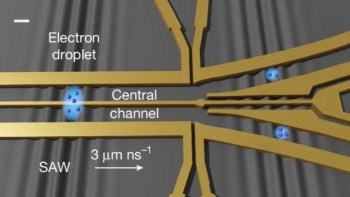
Physicists in Spain have calculated that substantial amounts of energy could be transmitted through air by using special materials to shape the magnetic fields around conductors. Although the concept has yet to be verified in the lab, the researchers say that it could lead to a viable method of transmitting electrical power, as well as applications in magnetic sensors and studies of the brain.
The idea of transmitting significant quantities of electrical energy without using wires has a long history. In 1891 Nikola Tesla showed that electricity could be sent through the air using induction coils. He continued to work on the idea alongside his work on wired transmission, but energy losses prevented its large-scale implementation.
Now Alvar Sanchez and colleagues from the Autonomous University of Barcelona have used the theory of transformation optics to propose a new way of concentrating and transmitting electrical energy. Transformation optics is usually associated with creation of invisibility cloaks, superlenses and other devices that guide and focus electromagnetic waves in ways not possible with conventional materials. This is done using metamaterials with special optical properties that transform space in much the same way as the presence of mass deforms space – as described in Einstein’s general theory of relativity. In the case of an invisibility cloak, electromagnetic waves can be made to move smoothly around an object, joining up on the other side as if the object wasn’t there.
Magnetic cloaking
The Barcelona-based team has already published a series of papers that apply transformation optics to magnetic fields. In 2011 the researchers collaborated with electrical engineers at the Slovak Academy of Sciences to build a cloak that shields a region of space from static magnetic fields. Now in this latest research, they have focused on how transformation optics could be used to cause a magnetic field in one place to induce a field somewhere else.
The team created a computer model of a transmitter-receiver system with a magnetic field source at the centre of a shell. The shell is made from a metamaterial with a magnetic energy density that would always be zero. In the case of power transmission, the magnetic field source would be a current-carrying coil.
The presence of the shell causes all the energy contained in the inner field to be delivered to the outer edge of the shell. Therefore the magnetic field radiated around the magnet into space is much stronger than if the shell had been a normal magnet or free space. If a second metamaterial shell were placed close by, the magnetic field of the first shell would then induce a magnetic response on the surface of the second shell. In this case, the effect of the shell is to transfer magnetic energy from outside of the shell to the centre of the shell without any loss.
Low frequency fields
So far, so good – however there is one important caveat. Strictly speaking, the analysis only applies to static magnetic fields. To transfer the energy of an electric current by creating a magnetic field – and then extract the energy as an electric current at the other end – would involve a magnetic field that changes with time. Nevertheless, Sanchez explains that the researchers have preliminary data suggesting that the analysis holds for very low frequency fields. “If we want to extract useful energy from our ideas, it is true that we should work on low-frequency AC fields,” he says.
Beyond energy transmission, the researchers suggest the ability of the shell to concentrate magnetic fields into a small space could enhance the accuracy of magnetic sensors. This could extend the reach of a medical research technique called transcranial magnetic stimulation, in which parts of the brain can be temporarily activated or deactivated by magnetic fields.
Transformation optics pioneer John Pendry of Imperial College London is intrigued by this latest proposal and by the researchers’ previous work using transformation optics to manipulate magnetic fields. He finds the work with static magnetic fields to be “even more exciting than optical cloaking, because it demonstrates the unique power of transformation optics to operate not just on rays of light, but to get inside the wavelength (infinitely long for static fields) and control the electric and magnetic field components of electromagnetism.”
The research will be described in a forthcoming issue of Physical Review Letters.



